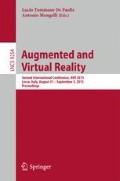Abstract
Combining physical and virtual objects in a computer game is becoming more and more popular, not only for players, but also for developers due to their flexibility in creating the game. We extended the idea by including a car-like Raspberry Pi robot, called OscAR which can be maneuvered through a realistic model city via a steering wheel and pedals, providing immersive gameplay. The gimmick in OscARsWelt is that the driver does not necessarily need to be personally on site, but can play our game from all over the world as long as he connects to our robot. To allow multiplayer gameplay, it is possible to join OscARsWelt as an additional player by using an Android device. The player has the choice to either support or to hinder the driver. Required to guarantee an immersive user experience are low-latency video streaming, a real-time-capable tracking system that remains stable while the robot is in motion, a fully remote-controllable car and a sufficient field of view.
Access this chapter
Tax calculation will be finalised at checkout
Purchases are for personal use only
References
Baker, S., Matthews, I.: Lucas-kanade 20 years on: a unifying framework. Int. J. Comput. Vis. 56(3), 221–255 (2004)
Cheok, A.D., Fong, S.W., Goh, K.H., Yang, X., Liu, W., Farzbiz, F., Li, Y.: Human pacman: a mobile entertainment system with ubiquitous computing and tangible interaction over a wide outdoor area. In: Chittaro, L. (ed.) Mobile HCI 2003. LNCS, vol. 2795, pp. 209–223. Springer, Heidelberg (2003)
Comport, A., Marchand, E., Pressigout, M., Chaumette, F.: Real-time markerless tracking for augmented reality: the virtual visual servoing framework. IEEE Trans. Visual. Comput. Graph. 12(4), 615–628 (2006)
Lin, C.-F., Pa, P.-S., Fuh, C.-S.: Mobile application of interactive remote toys with augmented reality. In: 2013 Asia-Pacific Signal and Information Processing Association Annual Summit and Conference (APSIPA), pp. 1–6. IEEE (2013)
Marchand, E., Spindler, F., Chaumette, F.: Visp for visual servoing: a generic software platform with a wide class of robot control skills. IEEE Robot. Autom. Mag. 12(4), 40–52 (2005)
Calonder, M., Lepetit, V., Strecha, C., Fua, P.: BRIEF: binary robust independent elementary features. In: Daniilidis, K., Maragos, P., Paragios, N. (eds.) ECCV 2010, Part IV. LNCS, vol. 6314, pp. 778–792. Springer, Heidelberg (2010)
Oda, O., Lister, L.J., White, S., Feiner, S.: Developing an augmented reality racing game. In: Proceedings of the 2nd International Conference on INtelligent TEchnologies for interactive enterTAINment, p. 2. ICST (Institute for Computer Sciences, Social-Informatics and Telecommunications Engineering) (2008)
Rosten, E., Drummond, T.: Fusing points and lines for high performance tracking. In: IEEE International Conference on Computer Vision, vol. 2, pp. 1508–1511, October 2005
Rosten, E., Drummond, T.: Machine learning for high-speed corner detection. In: Leonardis, A., Bischof, H., Pinz, A. (eds.) ECCV 2006, Part I. LNCS, vol. 3951, pp. 430–443. Springer, Heidelberg (2006)
You, S., Neumann, U.: Fusion of vision and gyro tracking for robust augmented reality registration. In: Proceedings of the Virtual Reality 2001 Conference, VR 2001, Yokohama, Japan, 13–17 March, pp. 71–78. IEEE Computer Society (2001)
Acknowledgments
The authors wish to thank Maximilian Luzius and Sebastian Prusak who also contributed to the development of OscARsWelt. This project initially started as a student project and was funded by the Institute for Computational Visualistics at the University of Koblenz-Landau in Germany.
Author information
Authors and Affiliations
Corresponding author
Editor information
Editors and Affiliations
Rights and permissions
Copyright information
© 2015 Springer International Publishing Switzerland
About this paper
Cite this paper
Hebborn, A.K. et al. (2015). OscARsWelt: A Collaborative Augmented Reality Game. In: De Paolis, L., Mongelli, A. (eds) Augmented and Virtual Reality. AVR 2015. Lecture Notes in Computer Science(), vol 9254. Springer, Cham. https://doi.org/10.1007/978-3-319-22888-4_11
Download citation
DOI: https://doi.org/10.1007/978-3-319-22888-4_11
Published:
Publisher Name: Springer, Cham
Print ISBN: 978-3-319-22887-7
Online ISBN: 978-3-319-22888-4
eBook Packages: Computer ScienceComputer Science (R0)

